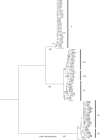Cyanobacterial ecotypes in the microbial mat community of Mushroom Spring (Yellowstone National Park, Wyoming) as species-like units linking microbial community composition, structure and function
- PMID: 17028085
- PMCID: PMC1764927
- DOI: 10.1098/rstb.2006.1919
Cyanobacterial ecotypes in the microbial mat community of Mushroom Spring (Yellowstone National Park, Wyoming) as species-like units linking microbial community composition, structure and function
Abstract
We have investigated microbial mats of alkaline siliceous hot springs in Yellowstone National Park as natural model communities to learn how microbial populations group into species-like fundamental units. Here, we bring together empirical patterns of the distribution of molecular variation in predominant mat cyanobacterial populations, theory-based modelling of how to demarcate phylogenetic clusters that correspond to ecological species and the dynamic patterns of the physical and chemical microenvironments these populations inhabit and towards which they have evolved adaptations. We show that putative ecotypes predicted by the theory-based model correspond well with distribution patterns, suggesting populations with distinct ecologies, as expected of ecological species. Further, we show that increased molecular resolution enhances our ability to detect ecotypes in this way, though yet higher molecular resolution is probably needed to detect all ecotypes in this microbial community.
Figures








Similar articles
-
Cyanobacterial construction of hot spring siliceous stromatolites in Yellowstone National Park.Environ Microbiol. 2012 May;14(5):1182-97. doi: 10.1111/j.1462-2920.2012.02698.x. Epub 2012 Feb 22. Environ Microbiol. 2012. PMID: 22356555
-
Cyanobacterial ecotypes in different optical microenvironments of a 68 degrees C hot spring mat community revealed by 16S-23S rRNA internal transcribed spacer region variation.Appl Environ Microbiol. 2003 May;69(5):2893-8. doi: 10.1128/AEM.69.5.2893-2898.2003. Appl Environ Microbiol. 2003. PMID: 12732563 Free PMC article.
-
Influence of molecular resolution on sequence-based discovery of ecological diversity among Synechococcus populations in an alkaline siliceous hot spring microbial mat.Appl Environ Microbiol. 2011 Feb;77(4):1359-67. doi: 10.1128/AEM.02032-10. Epub 2010 Dec 17. Appl Environ Microbiol. 2011. PMID: 21169433 Free PMC article.
-
A natural view of microbial biodiversity within hot spring cyanobacterial mat communities.Microbiol Mol Biol Rev. 1998 Dec;62(4):1353-70. doi: 10.1128/MMBR.62.4.1353-1370.1998. Microbiol Mol Biol Rev. 1998. PMID: 9841675 Free PMC article. Review.
-
Genomics, environmental genomics and the issue of microbial species.Heredity (Edinb). 2008 Feb;100(2):207-19. doi: 10.1038/sj.hdy.6801011. Epub 2007 Jun 6. Heredity (Edinb). 2008. PMID: 17551524 Review.
Cited by
-
Temporal metatranscriptomic patterning in phototrophic Chloroflexi inhabiting a microbial mat in a geothermal spring.ISME J. 2013 Sep;7(9):1775-89. doi: 10.1038/ismej.2013.52. Epub 2013 Apr 11. ISME J. 2013. PMID: 23575369 Free PMC article.
-
How adaptive immunity constrains the composition and fate of large bacterial populations.Proc Natl Acad Sci U S A. 2018 Aug 7;115(32):E7462-E7468. doi: 10.1073/pnas.1802887115. Epub 2018 Jul 23. Proc Natl Acad Sci U S A. 2018. PMID: 30038015 Free PMC article.
-
Microbial diversity of biofilm communities in microniches associated with the didemnid ascidian Lissoclinum patella.ISME J. 2012 Jun;6(6):1222-37. doi: 10.1038/ismej.2011.181. Epub 2011 Dec 1. ISME J. 2012. PMID: 22134643 Free PMC article.
-
Species matter: the role of competition in the assembly of congeneric bacteria.ISME J. 2014 Mar;8(3):531-540. doi: 10.1038/ismej.2013.180. Epub 2013 Oct 17. ISME J. 2014. PMID: 24132075 Free PMC article.
-
Recombination shapes the structure of an environmental Vibrio cholerae population.Appl Environ Microbiol. 2011 Jan;77(2):537-44. doi: 10.1128/AEM.02062-10. Epub 2010 Nov 12. Appl Environ Microbiol. 2011. PMID: 21075874 Free PMC article.
References
-
- Allewalt J.A, Bateson M.M, Revsbech N.P, Slack K, Ward D.M. Temperature and light adaptations of Synechococcus isolates from the microbial mat community in Octopus Spring, Yellowstone National Park. Appl. Environ. Microbiol. 2006;72:544–550. doi:10.1128/AEM.72.1.544-550.2006 - DOI - PMC - PubMed
-
- Bryant, D. A., et al Submitted. A phototrophic acidobacterium discovered by metagenomics.
-
- Cohan F.M. What are bacterial species? Ann. Rev. Microbiol. 2002;56:457–487. doi:10.1146/annurev.micro.56.012302.160634 - DOI - PubMed
-
- Cohan F.M. Toward a conceptual and operational union of bacterial systematics, ecology, and evolution. Phil. Trans. R. Soc. B. 2006;361:1985–1996. doi:10.1098/rstb.2006.1918 - DOI - PMC - PubMed
Publication types
MeSH terms
Substances
LinkOut - more resources
Full Text Sources
Molecular Biology Databases

